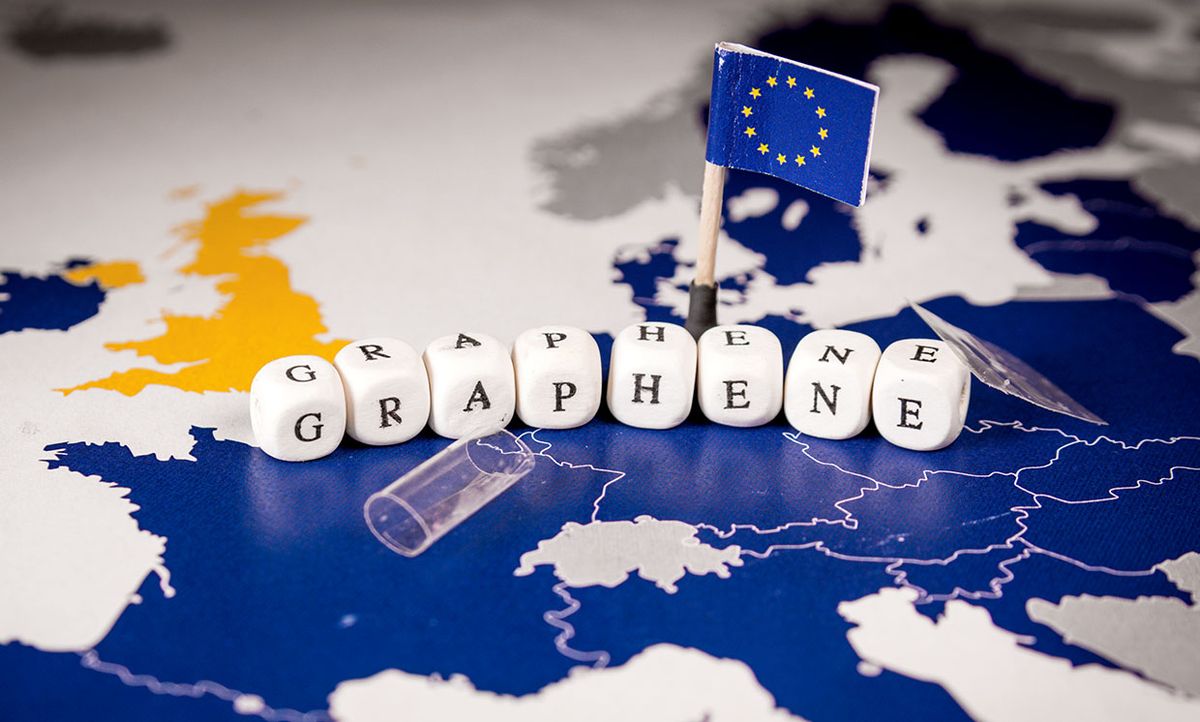Six years ago, the European Union (EU) embarked on an ambitious project to create a kind of Silicon Valley for the “wonder material” of the last decade: graphene. The project—called the Graphene Flagship—would leverage €1 billion over 10 years to push graphene into commercial markets. The project would bring together academic and industrial research institutes to not only ensure graphene research would be commercialized, but to also make Europe an economic powerhouse for graphene-based technologies.
To this day, the EU’s investment in the Graphene Flagship represents the single largest project in graphene research and development (though some speculate that graphene-related projects in China may have surpassed it). In the past six years, the Graphene Flagship has spawned nine companies and 46 new graphene-based products. Despite these achievements, there remains a sense among critics that the wonder material has not lived up to expectations and the Flagship’s efforts have not done much to change that perception.
Graphene’s unique properties have engendered high expectations in a host of areas, including for advanced composites and new types of electronic devices. While graphene can come in many forms, its purest form is that of a one-atom-thick layer of graphite. This structure has provided the highest thermal conductivity ever recorded—10 times higher than copper. It also has one of the highest intrinsic electron mobilities of any material (the speed at which electrons can travel through a material), which is approximately 100 times greater than silicon—a tantalizing property for electronic applications.
The Graphene Flagship is now more than halfway through its 10-year funding cycle. To many observers, the project’s achievements—or lack thereof—is a barometer for the commercial status of graphene, which was first synthesized at the UK’s University of Manchester in 2004, earning its discoverers the Nobel Prize in 2010. When it was founded, the Flagship wrestled with a key question that it still faces today: Was the Flagship set up to support “fundamental” research or “applied” research in its quest to make Europe the “Graphene Valley” of the world?

Jari Kinaret, director of the Graphene Flagship, says it’s the latter: “From the very beginning, our plan has been to take graphene and related materials from academic laboratories to society.”
Over time, he said, the project has intentionally funded more applied research. And, he points out, the consortium was originally made up of mostly academic groups, whereas today, about 40 percent of its members are companies.
However, some involved in the commercialization of graphene are not convinced that the Graphene Flagship is in the best position to lead graphene into commercial markets.
“There’s absolutely nothing wrong with funding fundamental research,” said Tim Harper, founder and former CEO of G2O Water Technologies Ltd , which uses graphene for water filtration systems. “But when this type of project is dressed up as commercialization and run by people with little interest in or experience with commercializing anything—but with a major interest in securing research funding—then it becomes more problematic by promising much more than it can likely deliver.”
Other industry observers echo this sentiment. Terrance Barkan, executive director of The Graphene Council, an association of researchers, producers, developers, and end-users of graphene, believes that the Graphene Flagship has been a boon for the university and academic community, but not had much impact at all on the material’s commercialization. (Disclosure: The author of this story has also worked for The Graphene Council). “For the money applied and for all the resources rallied, the Graphene Flagship is underperforming from a commercial development perspective,” Barkan said.
The Flagship does claim to have helped develop 17 commercial products based on graphene. One of these products is a flexible wireless sensor for measuring heart rates and other health parameters. Another is a graphene-coated motorcycle helmet that was launched commercially in 2016. The graphene keeps the helmet from getting damaged by impact or high temperatures.

In the case of the flexible wireless sensor, it’s no longer clear where exactly the sensor is in its commercial development cycle. The underlying technology was showcased at Mobile World Congress three years ago but no company appears to be selling it commercially today.
Kinaret does not see a sharp line between “fundamental” and “applied” research in the Flagship’s projects. Nonetheless, there is a rough division along these lines in the project’s next phase, known as Core 3, in which there is a growing emphasis on bringing technologies further along the development cycle. In this phase, the Graphene Flagship has allocated €45 million for projects aimed at Technology Readiness Levels (TRLs) 6 to 7, which means they should result in prototypes that function in realistic environments.
Harper at G20 Water Technologies believes this climb up the TRL ladder to 6 and 7 is not really necessary and may even be counterproductive. “In the commercialization of a technology, €45 million isn’t much,” he said. “Getting a hard-tech idea to market for one company takes tens of millions of euros. So even if every euro allocated by the Flagship mobilizes five private euros, it’s still only 20 or 30 companies across the whole of Europe and across all of the potential applications of graphene.”
In fact, Harper thinks any money spent by the Graphene Flagship to support commercialization may be misguided. “I’d forget about trying to commercialize graphene and push it into the market. It always fails,” he says. “The money would be better spent on TRL 1 through 5. That should be sufficient for the private sector to understand and exploit graphene.”
Another problem, according to both Harper and Barkan, is that the Graphene Flagship has been pursuing a “technology push” rather than “market pull” strategy for commercialization.
“The Graphene Flagship projects seem to be in the process of developing a solution that’s in search of a problem,” said Barkan. “The main observation I have made over the past six years of its existence is that the real progress in graphene commercialization has come from outside the Graphene Flagship.”
Barkan argues that the key to commercialization is to stop trying to adapt a graphene-based technology to a set of applications, but to speak to manufacturers directly and ask them what they need. At the Graphene Council, Barkan says, “We prioritize actually speaking with a wide range of companies and understanding what technical and business problems they are trying to solve and where graphene can play a role.”
One of the key problems in the commercialization of graphene—or any emerging technology—is bridging the gap between a technology that researchers have developed and rolling out a commercial product. This gap has been dubbed the “Valley of Death.”
To help graphene make it through, another project called the “Graphene & 2D Materials” EUREKA Cluster is currently seeking EU funding. Antonio Correia, president of the Phantoms Foundation, a European organization established in 2002 to coordinate nanotechnology innovation, is now spearheading the organization’s “Graphene & 2D Materials” Cluster project. Correia believes that this new effort is needed to take up the slack in the graphene development value chain.
While Correia thinks the Graphene Flagship has played an important role in bringing fundamental research and industrial concerns together, he believes the industry should guide how graphene is commercialized in the future. This focus on industry interests will become critical for graphene to bridge the Valley of Death, according to Correia.
Barkan offered another take on this industry-driven commercialization strategy: “At the end of the day, the question should be: What kind of a problem are you trying to solve where graphene unlocks new solutions?” he said. “Not—what type of innovation have you created that you are trying to push into a product?”
This story was updated on 4 June 2019.
A version of this post appears in the July 2019 print issue as “Where Does Graphene Go From Here?”
